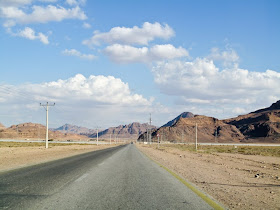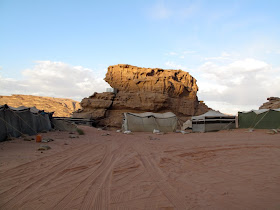Madaba to Wadi Rum is a 250km drive ... we followed our Garmin GPS which took us both off the beaten track (Surprisingly good "B" roads though!), as well as on highways of average condition!
Oooh ... arrival at Wadi Rum :-)
The Seven Pillars of Wisdom ... In the West, Wadi Rum may be best known for its connection with British officer T. E. Lawrence, who based his operations here during the Arab Revolt of 1917–18. In the 1980s one of the impressive rock formations in Wadi Rum was named "The Seven Pillars of Wisdom" in memory of Lawrence's book penned in the aftermath of the war.
We chose to stay at the Obeid Life Camp, and Nail (Obeid's son) was pleasant and met us at the gateway to Wadi Rum, and drove us in his old Toyota pick-up truck to the camp.
Located: Wadi Rum Protected Area
Contacts: Obeid and his son, Nail
Facilities: Running water, shower, sit-down toilet, large tent with heating, lots of blankets and mattresses, but I don't remember seeing a power socket (Remember to charge-up your phones and cameras beforehand!).
Other guests: None! Just us!!
Climate: It was cold, brrrrrr! About 15C and breezy in the day-time (This was mid-March), and 5C in the night.
Rate: 222 JD for three of us, or 1,150 AED or RM$900.
Includes: Three of us experienced ....
1) Pick-up from the gate of the Wadi Rum Visitors Centre to the camp, and back
2) Camel hike in the desert for 2 persons, for 1 hour
3) Dinner of home-cooked bedouin food (Delicious!) at the Obeid family home, in "civilisation" (Yes, bricks and mortar house, which is about 15 minutes drive from the camp)
4) Sleeping under the stars (In a tent!)
5) Breakfast of warm bedouin flat bread
6) Four hour desert "safari" (aka tour!) in a Nissan open-back pick-up
7) Simple lunch of warm flat bread, some tuna and humous, and lots of bedouin tea.
Our camp, and home for the day :-)
The rock formations are truly breathtaking ... And I was surprised how comfy the tent experience was, my first experience "camping"!
Wikipedia ... Wadi Rum has been inhabited by many human cultures since prehistoric times, with many cultures – including the Nabateans – leaving their mark in the form of rock paintings, graffiti, and temples. As of 2007, several Bedouin tribes inhabit Rum and the surrounding area.










No comments:
Post a Comment